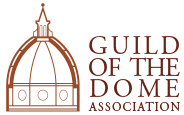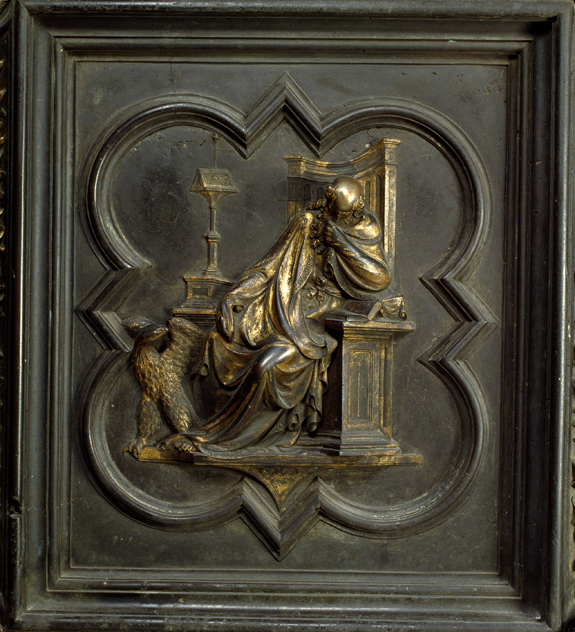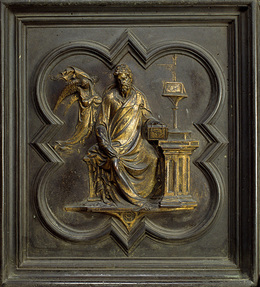Panel XXI - John
Panel details:
“in the beginning was the word, and the word was with god, and the word was god.” (John 1:1)
John, whose name in Hebrew means “the Lord is gracious, the Lord graciously gave”, was native of Galilee, an area on the shores of Lake Tiberias (perhaps bBthsaida Iulia) he presumably was born in Bethsaida in 10 ad and he died in Ephesus, 98-99 ad. He was the son of Zebedee and Salome and the brother of James the Greater.Although John’s family was well to do and had acquaintances among the high priests, he had never been to the school of the rabbis and therefore was considered “illiterate and a plebeian”. Some scholars have suggested that he dictated his own works, written by one of his disciples. His mother was part of the group of pious women who followed and assisted Jesus on the ascent to Calvary. It is said that she may have been a cousin of the Virgin Mary. John’s father ran a small fishing business with hired boatmen. the two brothers were called Boanerges (βοανηργές), “sons of thunder” (Mark 3:17). Traditionally, John has been given a special role within the circle of the twelve apostles, and is included in the small group with Peter and James the Greater. John is also identified as “the disciple whom Jesus loved”, as he was present at the main events of the life and ministry of his teacher and he was the only apostle to witness the death of Christ on the cross. According to early Christian tradition, John died at of old age in Ephesus, the last survivor of the twelve apostles. John is considered to be the first of the apostles to meet Jesus and the last living apostle, which concludes the apostolic mission aimed at illuminating the revelation. Christian tradition identifies him as the author of the fourth gospel, which is why he was given the epithet Evangelist. Christian tradition has attributed five texts of the new testament to him: the gospel according to John, the three letters of John and the revelation of John. An additional work attributed to him is the apocrypha of John.
There are no direct historical or archaeological references such as inscriptions referring to the life and works of John, nor are there any direct references in the works of ancient non Christian authors. There are three types of existing text sources relating to John’s personal life:
- the four canonical gospels and the acts of the apostles, written in Greek between the first century and the first half of the second century, which contain the only direct references to John’s life (the other New Testament writings traditionally attributed to him - the three letters of John and the revelation of John – do not provide any direct information regarding his personal life);
- some non-canonical writings attributed or referring to him, acts of John, apocrypha of John, interrogatio johannis (the questions of John), due to the late dates and legendary content cannot be considered historical sources, although it is possible that the oldest of these writings, the acts, does indeed contain some historically validated details ;
- there are a few references in the writings of some of the church fathers, mainly, Tertullian, Irenaeus, Eusebius and Jerome.
John’s calling is narrated in detail in the three synoptic gospels. The narrations of Matthew (4,21,22) and Mark (1,19-20) offer an essential recounting: the two brothers, John and James were called by Christ “at the sea of Galilee” while they were on the boat with their father Zebedee, repairing fishing nets. John’s calling was set immediately after that of Andrew and Peter, which took place in a similar environment. Luke instead set the calling within the “miraculous catch of fish” miracle. In the gospel of John, who adopted the identification of ‘’other disciple” for himself, the calling (John 1:35 to 40) is set in Bethany, near the Jordan river (John 1:28). John and Andrew, disciples of John the baptist, were invited by Jesus to follow him and he said to them, “behold the lamb of god”. The apostle and future evangelical narrator, recounts his calling in particularly vivid and precise detail: “the tenth hour”; that is, at four o’clock in the afternoon. A possible synchronization of the narrations in the gospels leads to the hypothesis that John’s first calling as well as that of the other future apostles took place first in Bethany, then upon their return to Galilee and later the definitive calling took place at the sea of Galilee. John, together with James and Peter, at the time when the three apostles were considered the favourites, attended some of the most important events of the life of the master. They witnessed the resurrection of Jairus’ daughter, the transfiguration, as well as the agony in the Gethsemane garden. John and Peter were commissioned to make the preparations for the last supper. John had a special role alongside the master during the last supper in Jerusalem, as he had the place of honour at the right hand of Jesus. John was resting his head on the breast of Jesus in a gesture of consolation and affection when upon Peter’s request, he asked the master the name of the traitor among them. over the centuries many famous artists have depicted this intensely dramatic scene in the “last supper”. John, even though he fled with the other apostles when Christ was arrested in Gethsemane, attended and witnessed the trial of Jesus and was the only one of the disciples present at the crucifixion. Jesus entrusted to him his mother Mary. After the resurrection of Christ, John and Peter ran to the tomb, and John was the first to recognize the master resurrected when he appeared in Galilee.
At the beginning of the thirties the story of a miracle was told about a man crippled from birth that Peter and John healed at the door, called beautiful, of the temple of Jerusalem (acts 3.1 to 11). The episode created such great commotion and resonance that it led to the arrest of the two apostles, who were brought before the sanhedrin. The council, however, did not punish them and let them go free (acts 4.1 to 21). In the mid-thirties (acts 5.17 to 42) an episode narrates the moment in which the high priest imprisons the apostles, who remain anonymous except for Peter. John is traditionally included in the episode, and though it has not been authenticated, it is likely, considering that he had been included in the previous episode. According to the biblical text, the apostles were miraculously liberated the same night they were imprisoned. The following day, they were arrested once more and sustained a second trial before the sinhedrin. A Pharisee named Gamaiele intervened in the apostles’ favour and the sinhedrin deciding to have them flogged and then freed. The last specific mention of John in acts (acts 8.14 to 25), describes the episode when the apostle is sent together with Peter to Samaria, where he encountered Simon the Sorcerer. concerning the years following the episodes narrated in acts, early Christian tradition agrees in setting John’s ministry in Asia (currently western Turkey), specifically in Ephesus, including a brief exile on the island of Patmos. The general chronological context however is less clear, and particularly, the date when John and according to tradition, Mary (based on John 19,26-27) moved to Ephesus, at the time of the fourth metropolis of the Roman empire (after Rome, Alexandria and Antioch) is unknown. It is possible the apostle moved to Asia before the council of Jerusalem, around 49-50, where he remained in the city of Paul for at least two years between 52-58, according to various hypotheses. John’s ministry left an evident imprint on the churches in Asia. There are various apocryphal stories narrating the episodes of John’s long stay in Ephesus, Patmos during his exile and his return to Ephesus where he died of natural causes. John represents a unique case among the twelve apostles as tradition indicates he died of natural causes and not as a martyr. This is the reason the liturgical vestments worn for his feast are white and not red. In addition to the acts of John, some patristic indications agree in dating his death in Ephesus during the reign of Trajan (98-117) and St Jerome specifies the date is precisely the 68th year after the passion of our Lord; that is, in 98-99. A centuries old tradition narrated by Tertullian and also reported in the Legenda Aurea (Golden Legend) by Jacopo da Varagine, recounts that John was martyred in Rome at the latin gate, during the persecution of Domitian in 89. when Domitian realized that the hot oil could not burn the body of the apostle, he blinded him and sent him back to Ephesus, where he died. In the sixth century, under emperor Justinian, a basilica was built in Ephesus, the place generally considered to be where John’s tomb lies and of which only traces remain today. In Patmos there is the cave of the apocalypse, referred to as the home of the apostle during his temporary exile. It was declared a Unesco world heritage in 1999, together with the Saint John Monastery. Based on the visions of the Augustinian Nun Anna Katharina Emmerik (1774-1824), at the end of the last century, archaeological research led to the discovery, about 9 km south of Ephesus, of Mary’s house (not to be confused with the “holy house” in Loreto), where the mother of Jesus and the apostle John appeared to have lived.
The five texts traditionally attributed to the apostle John explicate similarities in style and vocabulary, as well as conceptual and common theological themes. contemporary exegesis attributes the final edition of the texts not directly to John but to a school of authors-editors who followed the teachings of the apostle. In this context, “John’s theology” should be seen not as the direct result of a single scholar, but as the core of an ecclesiological tradition referring to him. John’s theology is really no different than that found explicitly or implicitly in other Christian writings of the new testament. Some of his concepts, however, are introduced or developed in his own, particular style that has found no equivalent in the other gospels.
All four evangelists are represented with their personal iconographic symbol. The four symbols are defined “tetramorph” (from the ancient Greek τετρα, tetra, “four”, and μορφη, morfe, “form”). The origin of adopting this iconographic representation consisting in four elements has pre-Christian origins, dating back to middle eastern symbolism. The figures composing the four symbols are man, lion, bull and eagle and are found in Mesopotamian greetings, called “Karabu” or “Karibu” (“blessed” or “pray”). These composite figures are mentioned in the bible in the prophecies of Ezekiel, “as for the likeness of their faces, they four had the face of a man, and the face of a lion, on the right side: and they four had the face of an ox on the left side; they four also had the face of an eagle” (Ezekiel 1: 10). Christian iconography used the version derived from John in revelation, “and the first beast was like a lion, and the second beast like a calf, and the third beast had a face as a man, and the fourth beast was like a flying eagle. and the four beasts had each of them six wings about him; and they were full of eyes within” (revelation 4: 7).
One of the oldest representations of John the evangelist can be found in the gospel called Rabbula. this is the conventional name of a Syrian gospel that probably came to Florence between 1522 and 1547. the gospel is in estrànghelo - the most ancient Syrian script – was written on two columns, most certainly in 586 by the monk Rabbula, at the convent of St. John of Beth Zagba in northern Syria.
John the Evangelist has been represented in diverse depictions over the centuries. Christian religious iconography often has represented him either as an innocent adolescent youth and almost androgynous, sitting close to Jesus at the last supper, either intently listening to Peter, as in the case of the last supper by Leonardo, or in the classic position with his head resting on the breast of the master.
The distinctive difference in Leonardo’s figure of John in his representation of the last supper compared to the other paintings of the last supper at the time, is the fact that Leonardo has depicted the apostle as he is turning to Peter who had motioned to him with a gesture of his hand to listen to the question, "tell me, who is the one he is referring to?" and not, instead, resting his head on Christ’s breast.
John has also been represented in depictions at the crucifixion of Christ where he is often placed at the foot of the cross together with Mary Magdalene and the Madonna.
John is furthermore represented holding a cup from which a snake is coming out. The cup with the snake recalls a legendary episode narrated by Jacopo da Varagine in the golden legend. Some time after the crucifixion of Christ, John went to Ephesus, and since the goldsmiths of the temple of Diana feared they would lose their business as a result of his preaching, the high priest of the temple, Aristodemus, obligated John to choose either to worship Diana, or to drink a glass of poisoned wine. John chose to drink the wine, but having made the sign of the cross over the chalice, the poison turned into a snake that slithered away. John was not poisoned or in no way harmed; thereupon, Aristodemus converted to Christianity.
John evangelist has been most commonly represented with his evangelical symbol, the eagle. He is depicted with a book in his hand both as a young man and older, as in Ghiberti’s panel for the North Door, either alone or together with other evangelists. This is the canonical iconography of the saint identifying John with his gospel.
Lorenzo Ghiberti created the panel depicting st John on the North Door of the Baptistery in Florence between 1403-15. The panel belongs to the first phase of his work, which still reflects the influence of late gothic style. His adherence to gothic-international influence is evidenced in the accented decorations of the figures, the draperies and in the rhythm of the composition that describes the scene. Ghiberti conformed to the international gothic style, while at the same time he introduced spatial perspective
innovations of the early renaissance style. The other panels created in the early stages of the work, together with the evangelists include agony in the garden, Jesus among the doctors, temptation of Christ, transfiguration, crucifixion, the last supper and the figures of the fathers of the church.
Ghiberti positioned the figure of the saint perfectly centred and inscribed in the quatrefoil frame. Saint John is sitting on a choir stall, clearly referring to the furnishings of the choirs in the churches of the period, as is the lectern, interpreted as a reduction of the ambo. These furnishings are presented in perspective and are placed on different layers in relief, to accentuate the perspective depth of the composition. the stall virtually "embraces” the saint, who is depicted in old age (confirming st John was indeed the only apostle to die of old age). The sitting figure has an air of dishevelment, with his head down in thoughtful reflection, absorbed in reading a book on the arm of the stall. An eagle is depicted at the foot of the saint. The figure of John is elegant with detailed drapery that suggests the posture of the limbs and creates the dynamic rhythm of the composition. Fine curls and a beard, reminiscent of the payot of the Jews frame the saint’s head, which is almost completely bald. His face is barely perceptible as the hand caressing his beard hides it. The eagle is depicted in naturalistic manner, possibly referring to the Roman imperial eagles of the classical age. It has been depicted in the act of spreading its wings; its head turned toward John, as if awaiting an order from him to take flight.
Donatello’s statue of Saint John for the facade of Santa Maria del Fiore in Florence is contemporary to Ghiberti’s creation. In the seventeenth century, a panel of St John after the iconography of Ghiberti's panel for the North Door of the Baptistery was carried out to complete the Pulpit of the Passion in the basilica of San Lorenzo in Florence.



